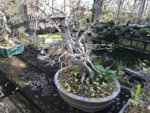Male-Female what's going on?
The genus Diospyros has about 200 species, the majority are sub-tropical to fully tropical. The genus Diospyros includes all true persimmons and all true ebony species. As a generalization ALL species generally are dioecious, meaning each tree produces imperfect flowers, that are only one gender or the other. So because a tree will only make either male or female flowers you generally need one of each. This is true whether you are talking about the culinary Japanese persimmon - kaki, or talking abou Ceylonese Ebony.
HOWEVER - The segregation is not perfect. There are occasional mistakes. So if you plant 1000 seedlings and flower them out, more than 99% will be either all male, or all female. But occasionally, at the rate of maybe 1 in 1000 will have one of two mistakes in them. Occasionally there is the clone that will have both male and female flowers on the same tree. Often it is mostly female with just a few male flowers. This is the case with Diospyros virginiana 'Meader', a self fruitful American persimmon.
The second mistake is that occasionally a female tree will flower, and if the flower does not get pollinated, the flower will still go ahead and make a fruit. The fruit will then be seedless. In the case of the culinary Japanese persimmon, Diospyros kaki, this is how you get those big persimmon fruit in the market that have no seed. The ability to produce seedless fruit if not pollinated is not a common mutation, but because D. kaki has been cultivated for fruit for at least 4000 years or more, there has been plenty of time to select and propagate only those clones of D, kaki that will make seedless fruit when no pollinator is around. Note, all these females that will produce seedless fruit if no male is around, will make fruit with seed if a male pollinator is present.
So there are 2 different natural mechanisms to get fruit without having a separate male tree. One is have a clone that produces both male and female, and the other is to have a clone that produces seedless fruit when no pollinator is around.
These mechanisms occur in all Diospyros species, but only the cultivated ones have they been selected for and become common.
Diospyros rhombifolia - Princess persimmon, - hardy at most to zone 7, I would protect from temperatures below +10 F or --12 C. They prefer bright shade. I have heard some females that produce seedless fruit have been identified in Japan. Most or all that are currently in USA need both male and female to produce fruit.
Diospyros virginiana - American persimmon - reliably hardy through zone 6, -10 F or - 23 C. Likes more sun than princess persimmon, part shade to full sun. Has rough square block, deeply fissured bark with maturity. Will fruit in as little as 7 years from seed. One clone 'Meader' has been identified as producing mostly female flowers with an occasional male flower, so somewhat self fertile. My information may not be correct but I believe the cultivar 'Yates' has shown it can produce seedless fruit if no male is present. Otherwise the vast majority of named clones and un-named seedlings need a separate male pollinator.
Diospyros kaki - Japanese persimmon, the culinary persimmon for commercial fruit. Because of the 4000 years of being bred and selected for a food crop, many clones, vast majority of clones that are named will produce seedless fruit if no male pollinator is present. So in general, if you purchase a grafted, named D. kaki, it will produce seedless fruit with no male present. Most are only hardy through zone 7. If a male is present, it will make fruit with seed.
Diospyros texana - Texas or Mexican persimmon - small black fruit, shrub similar to Princess persimmon except fruit is black. Native to middle and southern parts of Texas, south into Mexico. Fairly uncommon in cultivation. Definitely worth growing if you find Princess persimmon too expensive to get a hold of.
Diospyros digyna - Chocolate pudding fruit - a tropical persimmon, with fruit that does indeed taste like pudding, and if you use your imagination, chocolate pudding. Not frost tolerant. Separate male and female trees. Leaves are rather large, but do reduce, plan on larger size for bonsai. Not much in the way of selective breeding has been done, so no clones identified. Need male and female to get fruit.
There are a number of South African Diospyros that have bonsai potential, especially the ''crocodile barked persimmon''. I need to look up species names, my memory fails me here. Need separate male and female trees.
Majority of persimmon will fruit at less than 10 years from seed with good horticulture.











